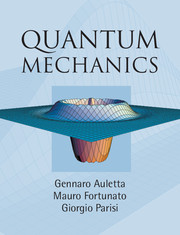Book contents
- Frontmatter
- Contents
- List of figures
- List of tables
- List of definitions, principles, etc.
- List of boxes
- List of symbols
- List of abbreviations
- Introduction
- Part I Basic features of quantum mechanics
- Part II More advanced topics
- 6 Angular momentum and spin
- 7 Identical particles
- 8 Symmetries and conservation laws
- 9 The measurement problem in quantum mechanics
- Part III Matter and light
- Part IV Quantum information: state and correlations
- Bibliography
- Author index
- Subject index
7 - Identical particles
Published online by Cambridge University Press: 05 June 2012
- Frontmatter
- Contents
- List of figures
- List of tables
- List of definitions, principles, etc.
- List of boxes
- List of symbols
- List of abbreviations
- Introduction
- Part I Basic features of quantum mechanics
- Part II More advanced topics
- 6 Angular momentum and spin
- 7 Identical particles
- 8 Symmetries and conservation laws
- 9 The measurement problem in quantum mechanics
- Part III Matter and light
- Part IV Quantum information: state and correlations
- Bibliography
- Author index
- Subject index
Summary
In classical physics, the question whether there are subsets of identical particles is not particularly interesting. After all, whether the particles are identical or not, we can always track each of them at any time. As we shall see, in quantum mechanics identical particles are indistinguishable because we cannot track trajectories, and this fact induces some important symmetry properties on the total wave function describing the system of particles under consideration. Generally speaking, a symmetry is an effect of an invariance, that is, the system does not change if one effects certain transformations (see Ch. 8). In this case, the system is not modified under exchange of two identical particles. Moreover, such a symmetry yields a most interesting connection between spin and statistics.
After a short introduction to the significance of statistics in quantum mechanics (in Sec. 7.1), we define the permutation operator and discuss the symmetry properties of the wave function of N identical particles (Sec. 7.2). In Sec. 7.3 we show that quantum particles, differently from classical particles (that obey the Maxwell–Boltzmann statistics), may be subject to two different statistics, namely the Fermi–Dirac statistics for fermions and the Bose–Einstein statistics for bosons. In Sec. 7.4 we treat the so-called exchange interaction and, finally, in Sec. 7.5 we consider some applications of the two statistics.
Statistics and quantum mechanics
Identical particles are those particles whose Hamiltonian is symmetric under exchange of one particle with the other.
- Type
- Chapter
- Information
- Quantum Mechanics , pp. 245 - 258Publisher: Cambridge University PressPrint publication year: 2009



